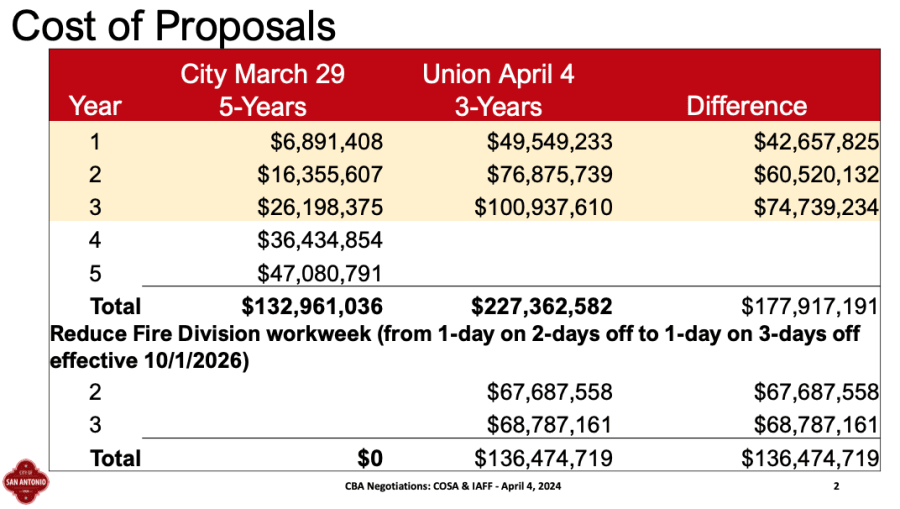San Antonio – The union representing San Antonio firefighters took a big swing Thursday, asking for much steeper pay raises than the City of San Antonio has offered.
The San Antonio Professional Firefighters Association proposed a series of bumps that would raise firefighter salaries 37.5% by October 2026. The city’s proposal, which it presented at the first collective bargaining session on March 29, would raise base pay 21.7% by January 2029.
The union has been itching to make up ground it has lost over the past decade, which has seen inflation grow by roughly three times the rate of San Antonio firefighters’ base pay.
However, the city’s lead negotiator, Deputy City Manager Maria Villagomez, said the raises the union wants, when combined with its other proposals, would be unaffordable for the city: an additional $364 million over three years, with the raises accounting for about half that.
Conversely, the city says its proposals would add up to $133 million over five years.
SAPFFA President Joe Jones told reporters the city was maxing out its estimates to prepare for a worst-case scenario.
The San Antonio Fire Department’s current annual budget is $373.8 million.
While there is a clear gap in the salary proposals, it’s less clear how much either side is willing to budge.
“We feel we have a very, very strong proposal,” Villagomez told reporters after Thursday’s bargaining session. ”We’ve never made a proposal that is as strong as we have made. (We’re) not going to make a lot of movement from where we are today.”
SAPFFA President Joe Jones, though, said the union’s pay proposal is what its rank-and-file membership wants to see.
“So, we’re sitting across from experts, but we’re also experts. We’re experts in what we do, and we know that we’re being overheated and overworked, and we know that our members are communicating that they feel underwhelmed by this offer,” Jones said.
The union has also asked to plan for a switch in fire department scheduling from a 24-hour on, 48-hour off rotation to a 24-hour on, 72-hour off. The city says that proposal alone would cost $136 million over two years, as it would require another 404 firefighters to be added to the department.


The city brought in an outside consultant, PFM Group Consulting, to analyze firefighters’ current compensation. Michael Nadol, one of PFM’s managing directors, said San Antonio offers competitive cash compensation to other Texas cities after additional incentives and “premiums,” like longevity pay, are taken into account.
However, the union’s team questioned Nadol’s analysis and pointed to a similar report his firm had done for the City of Austin, which appears to rank San Antonio firefighter pay less favorably.
Decade-old disagreement
Both sides have said they don’t want to re-litigate the past, but the tumultuous decade leading up to this contract has heavily shaped the negotiations.
Firefighters’ wages have only grown about 10.4% since the previous fire contract ended in September 2014. At the same time, inflation exploded by 30.4%, leaving the union anxious to make up lost ground.
Firefighters’ lagging pay is due to a combination of factors. After the previous contract ended in September 2014, the city and union fought for years at the negotiating table, in court, and at the ballot box. At the union’s request, a panel of arbitrators forced the current deal on both sides in February 2020.
The firefighters went more than seven years between the final October 2013 raise of the previous contract and the initial January 2021 raise of the new one. And the 10.4% raise over the life of that deal wasn’t what they had hoped.
This time around, the union’s wage proposal included both annual raises and what it called “equity adjustments,” which it says are needed to account for the inflation and the pay disparity they say they now have to San Antonio police officers.
“We want to look forward. Alright? We don’t want to look back,” said the union’s chief negotiator, attorney Richard Poulson. “And the proposed equity adjustment is not about litigating — re-litigating things that happened in the past. But at the same time, we can’t ignore it, right? So, the car’s in the ditch. You know, we can argue over how it got there, or we can focus on what do you need to do to get it out of the ditch and back onto the road.”
However, Villagomez said the city team feels the union is indeed negotiating for what happened over the past decade.
“Let me remind you that the police union negotiated twice over the past 10 years for the wages that they receive,” she said at the bargaining table on Thursday. “However, the fire union chose a different path. And the path that was chosen by the fire union was binding arbitration.”
Neither side appears eager to head back to arbitration to get a deal forced on them like last time.
Jones noted the union’s members haven’t had a chance to vote on a contract since 2009, while Villagomez has said the city wants to have a deal settled by the time the city proposes a budget in August.
See the breakdown of the city and union’s pay proposals below:
City pay proposal
- Jan. 1, 2025 - 4% raise
- Jan. 1, 2026 - 4% raise
- Jan. 1, 2027 - 4% raise
- Jan. 1, 2028 - 4% raise
- Jan. 1, 2029 - 4% raise
- While the raises add up to 20%, the total compounding effect works out to a 21.7% raise over five years.
SAPFFA pay proposal
- Oct. 1, 2024 - 4% raise & 11.7% “equity adjustment” (15.7%)
- Oct. 1, 2025 - 4% raise & 6% “equity adjustment” (10%)
- Oct. 1, 2026 - 4% raise & 4% “equity adjustment” (8%)
- While the raises add up to 33.7%, the total compounding effect works out to a 37.5% raise over three years.




